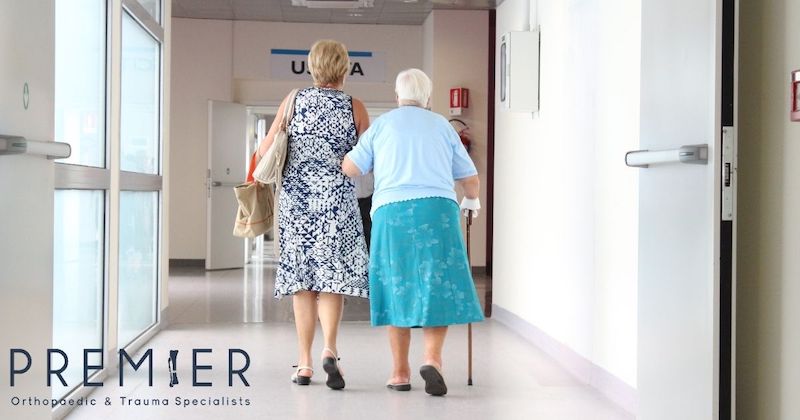Know Your Risk for Hip Fracture
Today we want to discuss one of the most important orthopedic and health issues facing much of our population today. Each year in the United States, more than 300,000 men and women over the age of 65 will fall and break their hip. This causes a huge burden to the patient themselves, their families and the medical system as a whole.

By all research and accounts, this number will continue to grow to be almost half a million patients in year 2050. So, as you can see this is a pandemic of its own, if you will, that needs to be addressed and discussed. 3/4 of the patients who fall and break a hip are women, who seem to suffer much more from osteoporosis. Most of these are due to falls in and around the house; but some are due to sidewalk falls, and a small portion due to traumatic accidents.
Many patients wonder what osteoporosis is. It is really just decreasing bone mass. So, in essence, our bones are more fragile. Bone is constantly turning over in our bodies. So, any time we get small injuries in our bones, our body repairs them. As we get older and as our hormones change, our body stops restoring bone, but continues to resorb or remove it. One of the reasons that females suffer much more from osteoporosis, and much sooner in life, is that after menopause, the change in hormones are what’s actually speeding up the bone loss. This is why it’s very important that we start preventative strategies early and not wait until we have severe osteoporosis.
The good news? There is preventative maintenance to help address these fractures and it really starts with understanding your risk.
What Can We Do to Lower Our Risk of Hip Fractures?
There are many steps patients can take to understand where they lie in the risk continuum and how to prevent some of them. Some of the prevention can be as simple as talking to your doctor or your pharmacist to see what medications you are on… making sure these medications are not inappropriately lowering your blood pressure to the point where you could pass out, fall and break your hip.
In addition to seeing your primary doctor, it’s also important to see an optometrist or an ophthalmologist to keep good track of your vision to ensure that you can see obstacles – to, again, lessen the risk of falling.
We also recommend that patients and their families go around their house and remove any items or objects that increase the chances of tripping and falling. Items around your house that are notorious for causing patients to trip are things like area rugs, side tables with legs that stick out and chairs or other tables that protrude out into the walkway. We also recommend having a large open pass around the house where there is no clutter to trip on.
The other item around the house is actually a family member, for most of us this is a pet or an animal that we love and cherish. It’s very important to be cognizant of where our pets are and always watch out, so you don’t trip over them.
Other simple items that families can help with is making sure there’s enough light around the house and add solid rails around the stairs to help going up and down stairs. Rails in the bathroom to help with balance may also be necessary.
One of the most important preventative measures that patients can take is exercise. We now have an understanding that patients of all ages need to make sure they perform daily exercise, including weight bearing exercises. This is why you may have noticed over the past 10 years, more and more of our aging population is in the gym, weightlifting, and involved in other exercises like Tai Chi. By continuing to exercise, we keep our bones stronger, slowing the loss of bone material and we also keep our muscles stronger, which helps our balance and supports our bones.
What Are the Medical Treatments That Can Help Lower My Risk for Hip Fractures?
Some of the simplest treatments that we recommend is taking vitamin D3 daily. Research has shown that vitamin D deficiency can lead to bone mass issues, even in sunny areas like California. Please talk to your primary care physician or your orthopedic surgeon to check your vitamin D level and get on an appropriate supplementation plan for vitamin D. In recent years, it has become clear that much higher doses of vitamin D are necessary then we originally thought.
Next, it is important that your primary care physician order a bone density exam also called a DEXA Scan. This is important as it will give your physician and your surgeon an objective measure of your bone mass and your bone density. This will help guide them in understanding how aggressively to treat your osteoporosis, if that’s what you have. Again, these can be simple measures like recommending exercise and vitamin D or recommending pharmaceutical medicines to help slow down your bone loss or increase your bone mass. As a side note, if you do start these medicines to treat osteoporosis, please continue to follow up with your primary care physician as some of them are not to be taken longer than five years.
So, after reading this I hope that you will talk to your families and your primary care doctor and take an assessment of what your risk for hip fractures are and make sure you take proactive steps to try and prevent them.
Dr. Hrayr Basmajian is the orthopedic trauma medical director at Pomona Valley Hospital Medical Center in Pomona California. He is the founder and CEO of Premier Orthopaedic and Trauma Specialists. Dr. Basmajian is known throughout the United States and the world for his expertise in the treatment of hip fractures including total hip replacement using the anterior approach.


 ES
ES